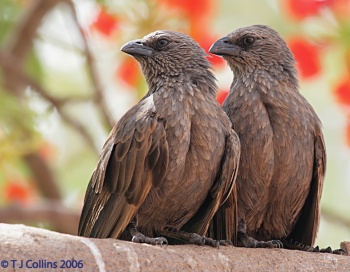(Attempt at cleaning up the page/ add misc) |
(Attempt at cleaning up the page) |
||
| Line 3: | Line 3: | ||
==Identification== | ==Identification== | ||
Length 29-33 cm. The Apostlebird is most often as seen in upper image: mostly grey with soft-looking body feathers. Flight feathers are brown, tail is black, legs are dark, the short, strong bill is black. However, the Birdforum Gallery (link below) show several images of birds with a much more reddish-brown color, be that due to true variation, staining, or an effect of unusual light conditions (see lower image). | Length 29-33 cm. The Apostlebird is most often as seen in upper image: mostly grey with soft-looking body feathers. Flight feathers are brown, tail is black, legs are dark, the short, strong bill is black. However, the Birdforum Gallery (link below) show several images of birds with a much more reddish-brown color, be that due to true variation, staining, or an effect of unusual light conditions (see lower image). | ||
| − | |||
| − | |||
==Distribution== | ==Distribution== | ||
| Line 11: | Line 9: | ||
==Taxonomy== | ==Taxonomy== | ||
| − | Two subspecies are recognized: ''cinerea'' and ''dalyi''. The only close relative of the Apostlebird is the [[White-winged Chough]]. | + | Two subspecies are recognized<sup>[[#References|[1]]]</sup>: ''cinerea'' and ''dalyi''. The only close relative of the Apostlebird is the [[White-winged Chough]]. |
==Habitat== | ==Habitat== | ||
| Line 21: | Line 19: | ||
Their flight has a characteristic pattern of flapping intermingled with gliding. | Their flight has a characteristic pattern of flapping intermingled with gliding. | ||
| − | + | This species engage in cooperative breeding where all members of a larger group are involved in nest construction, incubation and feeding of young. They build a nest that is a large mud bowl, placed on a branch in a tree<sup>[[#References|[2]]]</sup>. This group behavior apparantly lead to the name used for this species<sup>[[#References|[3]]]</sup>. | |
==References== | ==References== | ||
| + | # Clements, James F. 2007. ''The Clements Checklist of Birds of the World''. 6th ed., with updates to October 2007. Ithaca: Cornell University Press. ISBN 9780801445019 | ||
| + | #[http://www.birdsinbackyards.net/finder/display.cfm?id=133 Birds in Backyards] | ||
#[http://student.britannica.com/comptons/article-9309893/apostlebird Encyclopaedia Britannica] | #[http://student.britannica.com/comptons/article-9309893/apostlebird Encyclopaedia Britannica] | ||
| − | |||
==External Links== | ==External Links== | ||
Revision as of 03:02, 29 December 2008
- Struthidea cinerea
Identification
Length 29-33 cm. The Apostlebird is most often as seen in upper image: mostly grey with soft-looking body feathers. Flight feathers are brown, tail is black, legs are dark, the short, strong bill is black. However, the Birdforum Gallery (link below) show several images of birds with a much more reddish-brown color, be that due to true variation, staining, or an effect of unusual light conditions (see lower image).
Distribution
North, east, and south Australia. Highly nomadic.
Taxonomy
Two subspecies are recognized[1]: cinerea and dalyi. The only close relative of the Apostlebird is the White-winged Chough.
Habitat
Woodlands near water, farmlands with trees, roadsides, orchards and golf courses.
Behaviour
The diet includes insects and seeds.
Their flight has a characteristic pattern of flapping intermingled with gliding.
This species engage in cooperative breeding where all members of a larger group are involved in nest construction, incubation and feeding of young. They build a nest that is a large mud bowl, placed on a branch in a tree[2]. This group behavior apparantly lead to the name used for this species[3].
References
- Clements, James F. 2007. The Clements Checklist of Birds of the World. 6th ed., with updates to October 2007. Ithaca: Cornell University Press. ISBN 9780801445019
- Birds in Backyards
- Encyclopaedia Britannica





